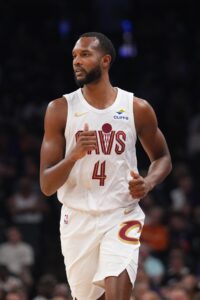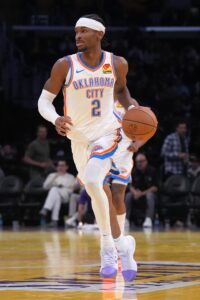As we detailed on Thursday within our story about Evan Mobley earning Defensive Player of the Year honors, the award represented a major financial boon for the Cavaliers big man, who significantly increased the value of his contract extension by virtue of being named this season’s Defensive Player of the Year.
Mobley signed a five-year, maximum-salary rookie scale extension last summer that included Rose Rule language. The Rose Rule allows a player and team to negotiate a maximum salary worth up to 30% of the cap (instead of the usual 25%) for a player with just four years of NBA experience if he makes an All-NBA team or wins the MVP or DPOY award.
Interestingly, Mobley’s rookie scale extension would’ve started at 27.5% of the cap in 2025/26 if he had made the All-NBA third team (instead of one of the first two teams) and hadn’t won Defensive Player of the Year.
Now that he has received DPOY recognition, it will instead start at 30%.
Here are the three scenarios that had been in play for Mobley, based on a projected 10% cap increase:
| Year | 25% of cap | 27.5% of cap | 30% of cap |
|---|---|---|---|
| 2025/26 | $38,661,750 | $42,527,925 | $46,394,100 |
| 2026/27 | $41,754,690 | $45,930,159 | $50,105,628 |
| 2027/28 | $44,847,630 | $49,332,393 | $53,817,156 |
| 2028/29 | $47,940,570 | $52,734,627 | $57,528,684 |
| 2029/30 | $51,033,510 | $56,136,861 | $61,240,212 |
| Total | $224,238,150 | $246,661,965 | $269,085,780 |
Mobley cashed in with his DPOY win, locking in a contract that projects to be worth in excess of $269MM over the next five seasons. Are there any other players who could join him by earning All-NBA nods this spring?
There’s only really one other guy who entered award season in the same boat as Mobley, waiting to see if his rookie scale extension worth 25% of the cap will increase to 30% of the cap. That player is Pistons point guard Cade Cunningham.
Cunningham looks like a pretty safe bet to be included on one of the All-NBA teams for 2024/25, and unlike Mobley, his contract doesn’t include any variable rates between 25% and 30% depending on which All-NBA team he makes. If Cunningham is a third-teamer, that would still be enough to bump his ’25/26 salary to 30% of the cap, matching Mobley’s deal.
Two other players signed Rose Rule extensions last offseason, but Magic forward Franz Wagner didn’t appear in enough games to qualify for All-NBA consideration and Raptors forward Scottie Barnes isn’t a serious candidate for the honor — their new contracts will start at 25% of next season’s cap.
There’s one other player to watch for potential super-max candidacy though — Grizzlies big man Jaren Jackson Jr. would become eligible for a super-max (ie. “designated veteran“) contract extension worth up to 35% of the cap if he’s one of this season’s 15 All-NBA players. He looks like a solid bet to make the cut after serving as Memphis’ most reliable offensive weapon and earning DPOY votes.
If Jackson earns an All-NBA spot, the Grizzlies would have three options when they enter extension talks with him this offseason:
- They could offer him a raise of up to 40% off his current contract, but that likely wouldn’t be enough to get a deal done, since his salary in the final year of his current deal in 2025/26 is just $23.4MM, a relatively modest figure for an All-NBA caliber player.
- They could use cap room to renegotiate his ’25/26 salary in order to give him a raise and then extend him off of that figure. This is a legitimate option, given that the Grizzlies are in position to potentially carve out a little cap room.
- They could sign him to a super-max extension that starts anywhere between 30% and 35% of the cap. Although it’s typical for players who sign super-max deals to get the full 35%, a team doesn’t necessarily need to go that high — when Utah extended Rudy Gobert after he became super-max eligible with a Defensive Player of the Year win, for instance, his deal started at a little over 31% of the cap.
Thunder guard Shai Gilgeous-Alexander will also be eligible to sign a super-max contract extension this offseason — that would still be the case even if he doesn’t win this season’s MVP award or make an All-NBA team (he’ll almost certainly do both), since he achieved the performance criteria a year ago.
The Rose Rule and super-max performance criteria call for a player to earn All-NBA, MVP, or DPOY recognition in either the preceding season or in two of the three preceding seasons, so Gilgeous-Alexander got there by making All-NBA teams in 2023 and 2024, even though he wouldn’t have enough years of service to sign his new deal until 2025.
No other stars are in position to meet that two-in-three-years criteria early this spring, like Gilgeous-Alexander did last year.
A player like Timberwolves guard Anthony Edwards, for example, is on track to make his second straight All-NBA team, but won’t meet the years-of-service criteria for a super-max extension until 2027. That means that even if he earns an All-NBA spot this year, Edwards will have to do so again in either 2026 or 2027 to be eligible to sign that deal in ’27, since the 2024 nod won’t be counted within the preceding three seasons at that time.
We’re likely still a few weeks away from learning this year’s full All-NBA results. A year ago, the league announced those teams on May 22.
 “Pick on
“Pick on  Mobley is the first player in Cavaliers history to win the award. He averaged 18.5 points, 9.3 rebounds, 1.6 blocks and 0.9 steals this season.
Mobley is the first player in Cavaliers history to win the award. He averaged 18.5 points, 9.3 rebounds, 1.6 blocks and 0.9 steals this season. While all three players put up monster numbers, Gilgeous-Alexander is generally considered the favorite to win the award due in large part to the Thunder’s team success this season. Oklahoma City won a league-high 68 regular season games, compared to 50 for Jokic’s Nuggets and 48 for Antetokounmpo’s Bucks.
While all three players put up monster numbers, Gilgeous-Alexander is generally considered the favorite to win the award due in large part to the Thunder’s team success this season. Oklahoma City won a league-high 68 regular season games, compared to 50 for Jokic’s Nuggets and 48 for Antetokounmpo’s Bucks. This award, introduced in 2017 and named after longtime NBCA executive director Michael H. Goldberg, is voted on by the NBA’s 30 head coaches, none of whom can vote for himself.
This award, introduced in 2017 and named after longtime NBCA executive director Michael H. Goldberg, is voted on by the NBA’s 30 head coaches, none of whom can vote for himself.